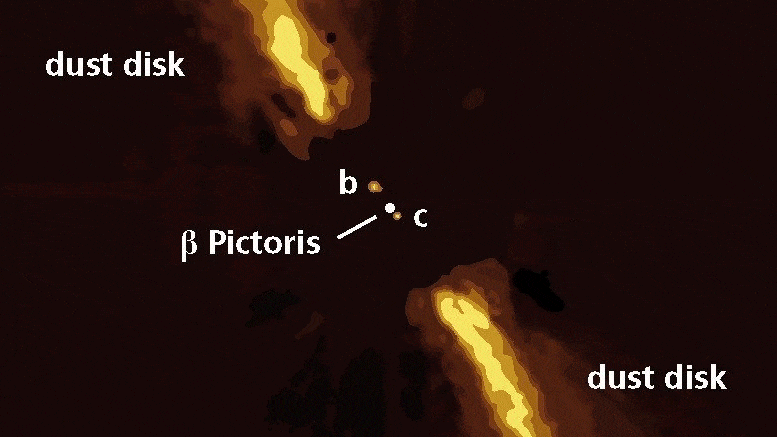These schematic images show the geometry of the β-Pictoris system: The image on the left shows both the star and the two planets embedded in the dust disk in the orientation that is visible from the solar system’s point of view. This view was created using information from actual observations. The middle field contains an artistic impression of the disk / planet system. The image on the right shows the dimensions of the system viewed from above and previous observations of β Pictoris b (orange diamonds and red circles) as well as the new direct observations of β Pictoris c (green circles). The exact orbit of planet c is still somewhat uncertain (blurred white area). Photo credits: Axel Quetz / MPIA graphics department
Astronomers using the GRAVITY instrument at the VLT telescopes in Chile have now received the first direct confirmation of one Exoplanet discovered by radial velocity. Since the planet “β Pictoris c” is in a tight orbit around its parent star, the faint glimmer of the exoplanet was observed directly next to the star’s glare for the first time. With these observations, astronomers can maintain both the flux and dynamic mass of exoplanets, which allows them to more narrowly constrain the formation models for exoplanets.
By combining the light from the four large VLT telescopes, the astronomers in the GRAVITY collaboration have succeeded in directly observing the glow of an exoplanet near its parent star. The planet “β Pictoris c” is the second planet orbiting its parent star. It was originally measured by what is known as “radial velocity,” which measures the drag of the parent star due to the planet’s orbit. β Pictoris c is so close to its parent star that even the best telescopes have not yet been able to image the planet directly.
“This is the first direct confirmation of a planet recorded using the radial velocity method,” says Sylvestre Lacour, director of the ExoGRAVITY observation program. Radial velocity measurements have been used by astronomers for many decades and have enabled the detection of hundreds of exoplanets. But never before have astronomers been able to observe one of these planets directly. This was only possible because the GRAVITY instrument, which is located in a laboratory under the four telescopes used, is a very precise instrument. It observes the light from the parent star with all four VLT telescopes simultaneously and combines them into a virtual telescope with the details necessary to reveal β Pictoris c.
“It is astonishing what level of detail and what sensitivity we can achieve with GRAVITY,” wonders Frank Eisenhauer, the lead scientist of the GRAVITY project at MPE. “We are only just beginning to explore breathtaking new worlds from the super massive black hole in the center of our galaxy to planets outside the solar system. ”
However, the direct detection with GRAVITY was only possible on the basis of new radial velocity data that precisely determine the orbital movement of β Pictoris c and was presented in a second article, also published today. This enabled the team to accurately pinpoint and predict the expected position of the planet so that GRAVITY could find it.
β Pictoris c is thus the first planet to be recorded and confirmed with both methods, radial velocity measurements and direct imaging. In addition to the independent confirmation of the exoplanet, astronomers can now combine the knowledge from these two previously separate techniques. “This means that we can now determine both the brightness and the mass of this exoplanet,” explains Mathias Nowak, the main author of the GRAVITY discovery paper. “As a rule, the more massive the planet, the brighter it is.”
In this case, however, the dates on the two planets are somewhat puzzling: the light coming from β Pictoris c is six times weaker than its larger sibling β Pictoris b. β Pictoris c has 8 times the mass of Jupiter. How massive is β Pictoris b? Radial velocity data will ultimately answer this question, but it will be a long time before enough data is available: a full orbit for planet b around its star takes 28 of our years!
“We had previously used GRAVITY to obtain spectra of other directly imaged exoplanets that already contained clues about their formation process,” adds Paul Molliere, who models exoplanet spectra as a postdoc at MPIA. “This brightness measurement of β Pictoris c in combination with its mass is a particularly important step in restricting our planet formation models.” Additional data could also be provided by GRAVITY +, the next generation tool already under development.



